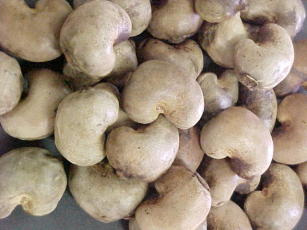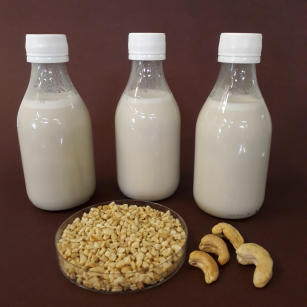Scientists develop cashew nut drink and add probiotics
Scientists develop cashew nut drink and add probiotics
Photo: Ana Elisa Sidrim

Studies demonstrated that the nut drink is a good vehicle to make probiotics availabe for consumers who cannot or choose not to consume dairy products
|
Embrapa developed a process to obtain cashew nut-based beverage and successfully tested the addition of probiotics. The product canbe consumed both by people with lactose intolerance and by those who follow diets without products from animal sources, such as vegetarian or vegan diets. The tests were successfully conducted on a pilot scale, and now the corporation looks for partners that are interested in making the product available in the market on a large scale.
According to Embrapa Tropical Agroindustry researcher Laura Bruno, the studies demonstrated that the nut beverage is a good vehicle to make probiotics availabe for consumers who cannot or choose not to consume dairy products. “These substances are commonly added to dairy drinks. During the process to obtain the cashew nut-based beverage, we had the idea to incorporate them to add further value to the product”, she reports.
For this purpose, they initially tested four probiotics available in the market. “All have proved viable in a month, which is fundamental, as they have to be alive to work in the human body”, explains the scientist.
The following stage was to choose four probiotics, with the stabilization of the product and the sensory analyses. “We opted for the one most commonly used in the dairy product market, which are the bifidobacteria (see box below). Laura explains that the inoculation (incorporation of the microorganisms to the beverage) of the probiotics is made after the beverage is obtained, because there is a sterilization stage during the process that eliminates any preexisting living organisms from it.
Once this stage is concluded, the duly probiotic-inoculated beverage is kept in a temperature of four degrees Celsius for a month. “During this period, we made microbiological analyses to observe whether there was presence of pathogens or of deteriorating microorganisms”, the researcher details. Another important step was the sensory analyses, which showed good consumer acceptance.
She explains that dairy drinks are the pioneers in adding probiotics, and today they are easily found on supermarket shelves in Brazil and abroad. “There is a tradition, since dairy was the first category of products to be studied for that purpose. And this is natural, since milk bacteria are reinoculated in processed drinks', she teaches.
Consumer demand moves science
The researcher observes that the growth of the market for vegetarian and vegan products combined with the demand for non-dairy products has made science turn to researching alternative products. This has occurred mostly due to the increase in the number of people with intolerance to milk and dairy. “In that sense, the cashew nut drink has proven to be a very interesting bet to add probiotics”, she assesses. “The inoculation of the nut beverage was not predicted in the initial project. It was an idea that appeared during the implementation of the studies and that worked out vey well”, she recalls.
| “Embrapa is available for partnerships with companies in the market that have an interest in the technology” ” |
The tests performed on a pilot scale have been considered successful so far. The next step will be production on a bigger scale. “For that purpose, Embrapa is available for partnerships with companies in the market that have an interest in the technology”, she reveals.
Drink to add value to broken nuts
During their processing, the rate of cashew nut breakage can be as high as 40%. This is a problem for the industry because the broken product is four times less valuable than whole nuts. As the Embrapa Food Technology researcher Janice Lima, who that at the time was working at the Embrapa unit in Fortaleza, was thinking about adding value to such undervalued cashew parts, she developed the process of producing the cashew nut drink - to which probiotics were later added.
The drink production basically consists in grinding the nuts with water and sugar, in ratios that the project defined, in order to obtain a homogeneous and stable emulsion. After that, there is a thermal treatment for microbiological quality assurance, resulting in a product that resembles milk. The process uses sterilization with ultra-high temperatures (UHT). There is the possibility of using sweeteners and flavorings to suit local preferences.
Janice Lima explains that oilseed and almond-based drinks as cow milk subsitutes are well-known in Asia but less popular in Brazil. However, the market is quite promising. The scientist recalls that a study conducted in April 2018 by the Brazilian Institute of Public Opinion and Statistics (Ibope), showed that 14% of the Brazilian population declared to be vegetarian, a 75% growth in vegetarianism in Brazil in comparison with the same survey from 2012. Currently, this number represents about 30 million Brazilians who claim to adopt this dietary option. The survey also indicated that 63% of Brazilians want to reduce their meat, egg, and dairy consumption and that they are looking for food options from plant sources. The study was detailed by the Brazilian Vegetarian Society (SVB).
Bifidobacteria: save that name
Bifidobacterium is a genus of anaerobic bacteria found in the gastrointestinal tract of breastfed infants. Species of lactobacilli and bifidobacteria have demonstrated beneficial effects over immunological processes and in the reduction and prevention of several intestinal disorders.
Nowadays there are many species of probiotic lactobacilli and bifidobacteria commercialy available. The study conducted by Embrapa tested three lactobacilli and Bifidobacterium animalis subsp lactis BB-12®. “This bifidobacterium was the object of many studies that back its probiotic nature, including clinical trials, with no reports of severe adverse effects, which is why it was chosen to be inoculated in the nut drink”, reports Laura Bruno.
Understanding probiotics
The intestines, especially the colon, contain a large number of microorganisms of hundreds of species. Estimates suggest there are over 40 trillion bacterial cells present in an adult human colon.
The World Health Organization (WHO) defines probiotics as live microorganisms that, when administered in adequate amounts, confer a health benefit on the host. Species of Lactobacillus and Bifidobacterium are most commonly used for that purpose.
Probiotics affect the intestinal ecosystem by impacting mucosal immune mechanisms, by interacting with commensal or potential pathogenic microbes, by generating metabolic end products such as short-chain fatty acids, and by communicating with host cells through chemical signaling.
Probiotics and prebiotics (substances that feed probiotics) can lead to antagonism of potential pathogens, an improved intestinal environment, bolstering the intestinal barrier, down-regulation of inflammation, and up-regulation of the immune response to antigenic challenges. These phenomena are thought to mediate most beneficial effects, including a reduction in the incidence and severity of diarrhea.
Source: World Gastroenterology Organisation guidelines
Photo: iStock
Translation: Mariana Medeiros
Verônica Freire (MTb 01125/CE)
Embrapa Tropical Agroindustry
Press inquiries
agroindustria-tropical.imprensa@embrapa.br
Phone number: +55 85 3391.7116
Further information on the topic
Citizen Attention Service (SAC)
www.embrapa.br/contact-us/sac/


